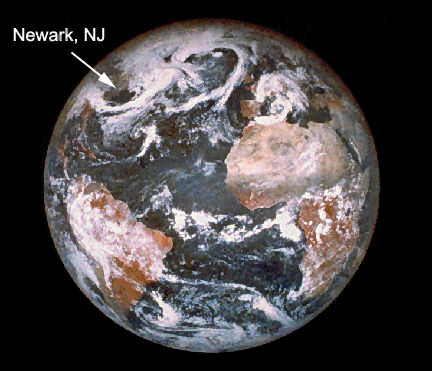
Samantha StudentBut the Earth is only one of nine planets orbiting the Sun--the center of the solar system--so our cosmic address had better say which planet we are on:
NJIT
323 M L King Blvd
Newark, NJ 07102-1982
USA
Samantha StudentBut specifying the planet is not enough--these nine planets orbit our star, the Sun, but we now know of at least
NJIT
323 M L King Blvd
Newark, NJ 07102-1982
USA
Earth
Samantha StudentThis address ought to be enough for awhile. We can explore all of the 100 billion stars of our galaxy, and this address will be enough to find us. But eventually, who knows, we may enlarge the postal system to include other galaxies! The official name of our galaxy is the Milky Way Galaxy, so our more complete address is:
NJIT
323 M L King Blvd
Newark, NJ 07102-1982
USA
Earth
Solar System
Samantha StudentHow many galaxies are there? There may be as many as 100 billion galaxies, (they are not all counted!) each with up to 100 billion stars! Galaxies are not spread uniformly in the Universe, however, but are found in groups and clusters. Our galaxy is one of the largest members of a group of galaxies known as the local group, along with the Andromeda Galaxy (shown below) and several other galaxies (two others can be seen in the same photo).
NJIT
323 M L King Blvd
Newark, NJ 07102-1982
USA
Earth
Solar System
Milky Way Galaxy

We need to specify our group, to distinguish from other clusters of galaxies, such as the giant Virgo Cluster. The address becomes:
Samantha StudentAs it turns out, galaxies show even larger groupings, or clusters of clusters, known as superclusters. As the postal system grows to galaxies outside the local group, we will need to specify which supercluster our group belongs to. We refer to it as the local supercluster. So now the address is:
NJIT
323 M L King Blvd
Newark, NJ 07102-1982
USA
Earth
Solar System
Milky Way Galaxy
Local Group
Samantha StudentThe overall structure of superclusters can be mapped in surveys such as the one below, from the 2dF Redshift Survey.
NJIT
323 M L King Blvd
Newark, NJ 07102-1982
USA
Earth
Solar System
Milky Way Galaxy
Local Group
Local Supercluster

Samantha StudentLecture Question #3
NJIT
323 M L King Blvd
Newark, NJ 07102-1982
USA
Earth
Solar System
Milky Way Galaxy
Local Group
Local Supercluster
The Universe